Foxconn Blood Rage - If Looks Could Kill (UPDATE)
by Rajinder Gill on January 2, 2009 6:00 AM EST- Posted in
- Motherboards
It's All About Brawn... Well, Maybe
 If your CPU and parts are anything like ours, you'll soon find that this "Force Reset" button is your new best friend. |
We're not sure if our situation is unique, but that statement above relates to the fact that all three of our boards refuse to cold or stop-cycle-boot without pressing the "Force Reset" button. Once the board is running, we can apply changes to BCLK reference clocks as long as we don't change major parameters such as clock multipliers. Foxconn's manual states that use of this button resets the system and tunes the board to perform optimally with your components. We think it's primary use is related to boot up memory module read/write leveling performed by the IMC to sense module density/capacitive loads and apply clock/data skew table algorithms and/or a simple reset of all IRQ assignments. This is something that usually happens during the black screen period of the boot cycle on other boards.
As an override, the idea is sound as those of us who push components find ourselves frequently going through complete power cycles to bring boards back to boot. For us though, our boards refuse to function properly without it. Regardless of stock speeds, moderate overclocks, or the more out-on-a-limb stuff, we need to press this button every time to get the board to fire up from a change to a related BIOS function. In order to overcome this we tried PSU swaps and five brands of memory using various ICs and attendant SPDs. A BIOS update should easily fix this problem if the boot cycle configuration is moved back into automated hands. We've alerted Foxconn to this and hope to hear back from them soon. If you happen to stumble across a combination of parts that results in this scenario, you'll need to keep the side panel off your PC case. However, if you run your motherboards out of a case -- as most benchmarking fanatics do -- this probably won't bother you.
Let's press on and get down to the maximum stable speeds we achieved. First up, we have a PCMark Vantage full suite pass at 4.1GHz.
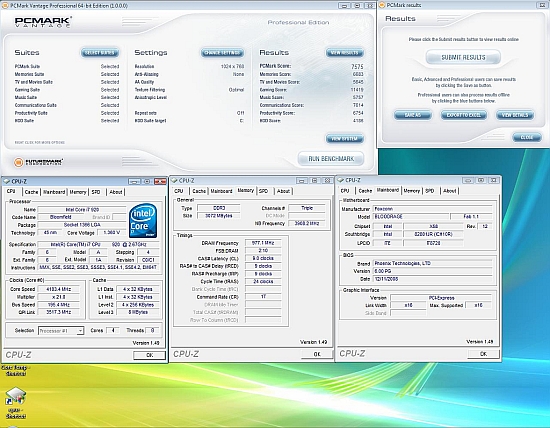 |
This overclock is right on the limits of our water-cooled setup for 24/7 use. 100% processor load temps are in the region of 75C, about as far as we'd expect the processor to remain stable and over the sensible mark for many. VTT/Uncore voltage is critical and needs a sizable boost over stock to around 1.52V for Vantage to pass a full test suite loop on our retail i920 processor.
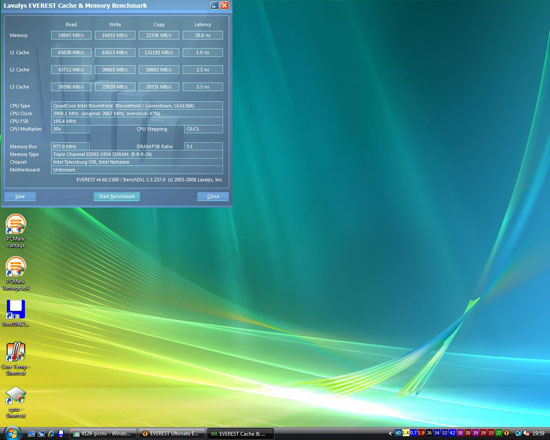 |
Everest Bandwidth on the Nehalem platform is beyond reproach using triple channel memory. In truth, there's little benefit running past 1600MHz, but we thought we'd try it as the Blood Rage virtually demands it. (This and the fact that the Kingston kit is specified to run 2000MHz at 1.65V). On a side note, longer eight thread enabled Prime95 runs were destined to fail unless we increased the Uncore voltage to around 1.54-1.56V. Using a lower memory divider ratio decreases the level of Uncore Voltage required; using the 2:8 divider resulted in a fully stable pass at 1.47V. The required level of Uncore voltage is largely processor dependant, though board design does come into play as we have noticed on the DFI and ASUS boards. With a good CPU, you may get away with less voltage.
Dropping the BCLK reference to 190MHz brings the required level of Uncore voltage down to 1.45V while running the 2:10 memory ratio at 1915MHz 1T in triple channel configuration. This passes a 1 hour OCCT run, multiple loops of PCMark Vantage, and several games with ease.
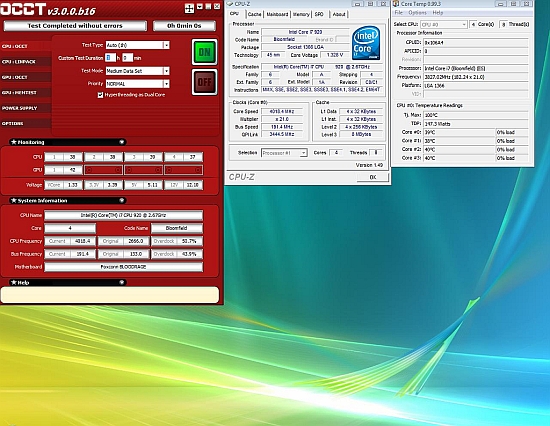 |
We included our test BIOS settings below for those that want to set up the board quickly before tuning it. However, there's not really much to it on this platform, other than the golden rule of keeping VTT/Uncore voltage within ~0.5V of VDDQ (VDIMM). Until we discuss additional secrets of Nehalem overclocking in the coming i7 Guide, it's a game of setting four or five key voltages and letting the BIOS do the rest. One other note to remember is to set the Uncore frequency to a minimum of 2X the memory multiplier. Failure to do so will result in a non-boot in all manual setting situations.
 |
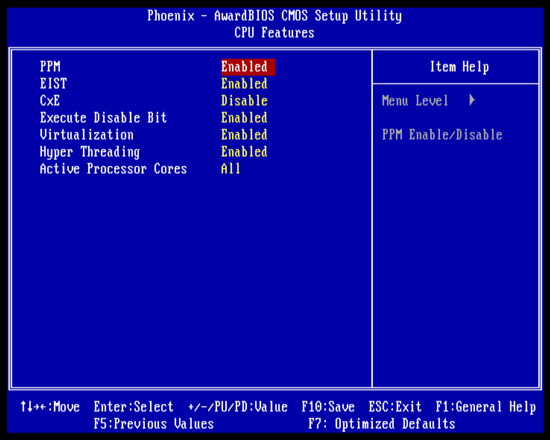 |
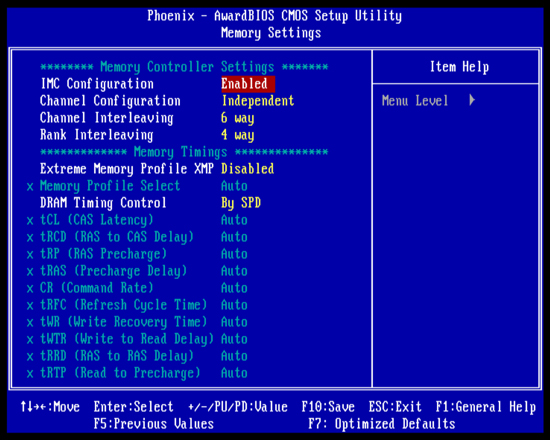 |
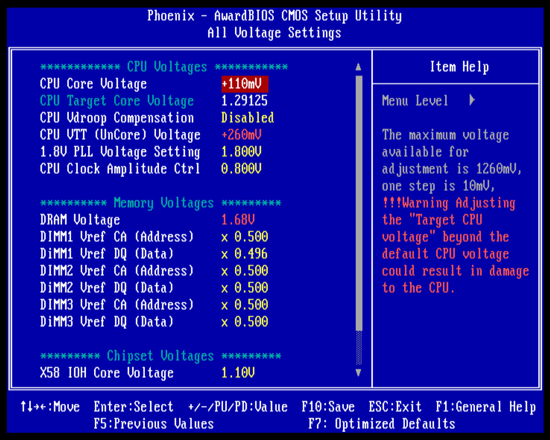 |
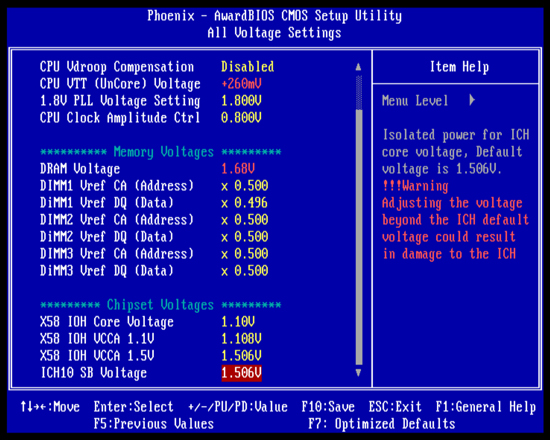 |
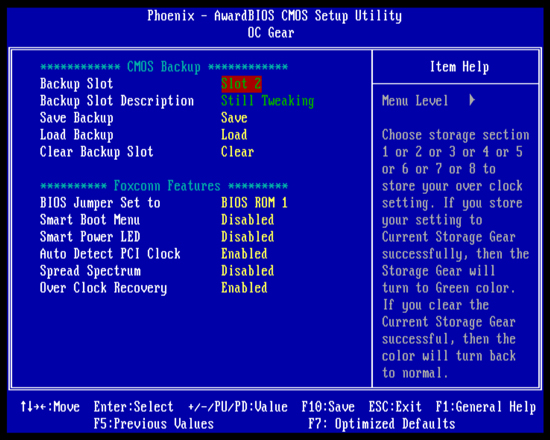 |
On the voltages screenshot you will notice that DIMM1 DQ Ref voltage is set to 0.496X. We found this situation manifests itself whenever we ran our Kingston or G.Skill DDR3-2000 memory in a triple channel configuration. All things being ideal, these values should retain as close to 50% of VDDQ (VDIMM) as possible, unless overshoot and ringback signal effects are affecting the DATA DQ sampling window excessively (which can and does happen at higher bus frequencies).
There is a massive 62 step scale available for each of the ref voltage levels; however DIMM1 remains locked to 0.496V regardless of what you select in BIOS. We tried multiple times to reset this value to 0.50X but found the board would reset to 0.496X after boot every time. We're not sure if this is a "red-button artifact" or if this is a BIOS bug at this point. We are leaning towards a BIOS bug, as a manual user setting should work properly. If it is a bug, then a change as small as this is in the wrong direction is enough to result in an incorrect logic interpretation at very high memory speeds. We have alerted Foxconn to this and await a response.










66 Comments
View All Comments
gemsurf - Friday, January 2, 2009 - link
Absolutely! Why pay any homage to a company like Foxcon that releases this crap to the unsuspecting public! Most early adoptee's will have dropped about a grand counting memory and a processor only to be a friggen frustrated betatester! That sucks and should be pointed out for what it is! A crappy company! Anandtech has the clout to be heard saying just that and it's time you did it everytime something "released to market" that doesn't work properly!JonnyDough - Friday, January 2, 2009 - link
I agree. They BLOW. Support for bios updates and drivers is lacking bad. I could even say the same for Phoenix who makes the BIOS for their boards. If you go to their website (because FoxConn BIOS are years old) and want an update to your BIOS you have to pay for a subscription to a driver update program. I guess nothing in life is free, except that I PAID FOR THE MOTHERBOARD. Which, I guess should mean that they support it for AT LEAST FIVE YEARS.Anyway, my experience with FoxConn has been dismal at best. They have no real American tech/website support to speak of. Steer clear.
JEDIYoda - Friday, January 2, 2009 - link
You will never ever satisfy all the people all the time. So continue to do your very best!!In fact some people with complaints just enjoy complaining!!
Gasaraki88 - Friday, January 2, 2009 - link
NO, I want you to call out the manufacturer and say that this is a bad motherboard because IT DOESN"T EVEN WORK OUT OF THE BOX! You do know that this mobo is for sale now in the general public right? If this was a pre-release board for reviewers then fine, but a retail board that can't boot properly? Come on...The0ne - Monday, January 5, 2009 - link
This isn't new, MBs have been shipping with bad BIOS firmwares for some time now. Even if sites like Anandtech were to find the issues, the MBs are going to make it out to the public as is. We as the consumer can only pray that they will have a fix, sooner than later.On this particular subject I am really disgusted at the companies for not doing a better job. As an Engineer myself I have to ask whether I'm happy with the current state of development to release it to the public or not. And if the MB is buggy with it, then DON'T ship it until you can stabilize it. Of course you have the QA and testing that might be missing as well. Shame really.
The0ne - Monday, January 5, 2009 - link
sry, website didn't process so clicked 3 times :/The0ne - Monday, January 5, 2009 - link
This isn't new, MBs have been shipping with bad BIOS firmwares for some time now. Even if sites like Anandtech were to find the issues, the MBs are going to make it out to the public as is. We as the consumer can only pray that they will have a fix, sooner than later.On this particular subject I am really disgusted at the companies for not doing a better job. As an Engineer myself I have to ask whether I'm happy with the current state of development to release it to the public or not. And if the MB is buggy with it, then DON'T ship it until you can stabilize it. Of course you have the QA and testing that might be missing as well. Shame really.
The0ne - Monday, January 5, 2009 - link
This isn't new, MBs have been shipping with bad BIOS firmwares for some time now. Even if sites like Anandtech were to find the issues, the MBs are going to make it out to the public as is. We as the consumer can only pray that they will have a fix, sooner than later.On this particular subject I am really disgusted at the companies for not doing a better job. As an Engineer myself I have to ask whether I'm happy with the current state of development to release it to the public or not. And if the MB is buggy with it, then DON'T ship it until you can stabilize it. Of course you have the QA and testing that might be missing as well. Shame really.
gemsurf - Friday, January 2, 2009 - link
Well, I'm a consumer (system builder) and I have yet to see an X58 board that is ready to market? Everything you have tested or teased with "has issues" and were not ready to market from what I can gather. So I guess what I would like to see is articles or follow ups on items that are really up to the promises on the box? Are there any because everything I've read here since the X58 release seems to have bios issues. Is the best board out there just the one with the fewest issues? Are they ready to trust across 25 mission critical workstations? I'm left with the impression that no, they are not? Seems these manufacturers want us to buy them and wait for the bios updates? If thats the case, then all I really expect is for you to say it that way.Exar3342 - Friday, January 2, 2009 - link
I have yet to hear any issues from the Gigabyte or Asus X58 boards (I happen to have used both myself) and each is rock-solid. Quit spreading FUD.